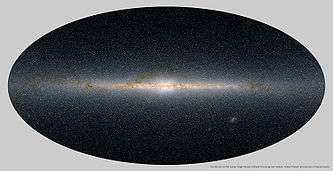Zone of Avoidance

The Zone of Avoidance (ZOA) is the area of the sky that is obscured by the Milky Way.
Term
The ZOA was originally called the "Zone of Few Nebulae" in an 1878 paper by English astronomer Richard Proctor that referred to the distribution of "nebulae" in Sir John Herschel's General Catalogue of Nebulae.[1]
Background
The attenuation, interstellar dust and stars in the plane of the Milky Way (the galactic plane) obstruct our view of around 20% of the extragalactic sky at visible wavelengths. As a result, optical galaxy catalogues are usually incomplete close to the galactic plane.
Modern developments
In recent years, many projects have attempted to bridge the gap in our knowledge caused by the Zone of Avoidance. The dust and gas in the Milky Way cause extinction at optical wavelengths, and foreground stars can be confused with background galaxies. However, the effect of extinction drops at longer wavelengths, such as the infrared, and the Milky Way is effectively transparent at radio wavelengths. Surveys in the infrared, such as IRAS and 2MASS, have given us a more complete picture of the extragalactic sky. Indeed, two very large nearby galaxies, Maffei 1 and Maffei 2, were discovered in the Zone of Avoidance by Paolo Maffei by their infrared emission in 1968. Even so, approximately 10% of the sky remains difficult to survey as extragalactic objects can be confused with stars in the Milky Way.
Projects to survey the Zone of Avoidance at radio wavelengths, particularly using the 21 cm spin-flip emission line of neutral atomic hydrogen (known in astronomical parlance as HI), have detected many galaxies that could not be detected in the infrared. Examples of galaxies detected from their HI emission include Dwingeloo 1 and Dwingeloo 2, discovered in 1994 and 1996 respectively.
Notes
- ↑ Kraan-Korteweg & Lahav 2000, p. 2
References
| Look up zone of avoidance in Wiktionary, the free dictionary. |
- Kraan-Korteweg, Renée C.; Ofer Lahav (May 24, 2000). "The Universe behind the Milky Way". The Astronomy and Astrophysics Review. arXiv:astro-ph/0005501. Bibcode:2000A&ARv..10..211K. doi:10.1007/s001590000011.
- R. C., Kraan-Korteweg; Staveley-Smith, L.; Donley, J.; Henning, P. A. (November 5, 2003). "The Universe behind the Southern Milky Way". Maps of the Cosmos - ASP Conference Series. International Astronomical Union. arXiv:astro-ph/0311129.
| |||||||||||||||||||||||||||||||||||||||||||
